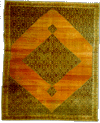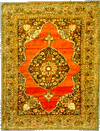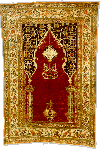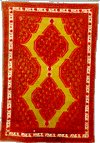

There is no trace of Persian carpet which brings back to periods of
time before the XVI century. The art of knotting in Persia was probably
practised also before that period thanks to natural comparison between
neighbouring people and to nomad phenomenon foreboding exchanges. As a
matter of fact there are miniatures of the period preceding the XVI century
that testify this and show manufactures of clear derivation from Anatolic
medieval carpet. They date back to the beginning of the XV century and
show royal or heroic figures on carpets with geometrical decorations and
kufic types. . 
In three miniatures, contained in the manuscript called "The Book of the Kings" written by the Arabian Firausì (XIV century) three carpets are described; two of these emphasize in the central part a drawing with crossing ovals "as can not be found on any of the following Persian carpets". During the preceding period similar drawings could have been made in Caucasus. On the third carpet there are stylized figures of animals in double octagon, similar to those which can be found in Anatolic carpets of the XIV century. These artists have reproduced samples which they knew. Clearly, in that period, that was the kind of carpet produced in Persia. They would probably have produced a different model, if they have had one. Later miniatures and pictures show no longer geometrical carpets, but carpets with medallions and floral decorations.
The arrival of safawide
It is impossible that in Persia the art of the carpet could suddenly
burst for exclusive will of a dynasty, if no local production had already
existed, even if a demotic-artisan one; it was, as said before, a production
with starting characteristics very similar to Anatolic and Caucasic ones.
Already the "red" Ismail (as known from the last calendar of the "Market
in Persia" of the 2nd July 1520) reorganized the production of carpets.
Afterwards, the whole dynasty (particularly Tahmasp and Abbas the Great)
endeavoured in the same way thanks to the enlightened management of the
governors and particularly thanks to the new political and religious incentive
(Shiitism) of which they were spokesmen. The carpet becomes one of the
most typical expression of Persian art; Shite current - which is directly
connected to koranic precepts  more
than to religious tradition - gives vent to fantasy; so that the carpets
get richer with endless new motifs. The whole decoration gets richer with
leaves and rolled up stalks. Central medallion was born, then hunting,
vases, arabesques, floral decorations, gardens and animals, as well as
figures in different postures, as koranic law did not forbid it:
it only ordered to avoid impurities of the idols. Let's say
again that it had been Yhedith, that is the tradition, faithfully followed
by Sunnite Turkish people, to state that no representation of living beings
was allowed, so that the artist was not in competition with the only and
absolute creator Allah. The art of the carpet up to the end
of XV century is then daughter of Sunnite tradition. The broad-mindedness
of the Safawidi (so called by the founder Safi-ed-Din) was a political
attitude more then just an artistic tendency of the sovereigns (it must
be remember that Shah Abbas himfelf loved devoting to the knotting of the
carpets). In fact, to gain people consent, political sensitivity suggested
to leave more freedom to creative spirit of a people of such a long and
prooved civilization. This dispute forced particularly Ismail and Tahmasp
to hard struggles; the had to defend the wide Iranic territory with weapons,
they had alternate vicissitudes which forced them to move the capital from
Tabriz to Kazvin and to other towns, until the empire consolidated under
the reign of Shah Abbas I, who settled the capital in Isfahan. The arrival
of safawide was the new fact which produced a new way in carpets manufacturing.
No comparison with the past is possible. Centres of production and factories
increased; new ones were established which worked for and at the Court
("Karkhanehs", royal workshops) to produce the famous courtly Persian carpet,
which will reach every country of the world thanks to the flourishing of
industry and commerce. The material is the best one: golden and silver
threads are sometimes added to wool and silk, looms are improved and enlarged.
But what is really important is that miniature, painting and binding artists
are engaged to prepare the cardboards and all qualified skilled workers
are moved all through Persia. Tabriz, Kashan, Kirman, Herat become cardinal
points and Shiraz, Isfahan, Zazvin, Ioshagan Yazd and others add
to them.
more
than to religious tradition - gives vent to fantasy; so that the carpets
get richer with endless new motifs. The whole decoration gets richer with
leaves and rolled up stalks. Central medallion was born, then hunting,
vases, arabesques, floral decorations, gardens and animals, as well as
figures in different postures, as koranic law did not forbid it:
it only ordered to avoid impurities of the idols. Let's say
again that it had been Yhedith, that is the tradition, faithfully followed
by Sunnite Turkish people, to state that no representation of living beings
was allowed, so that the artist was not in competition with the only and
absolute creator Allah. The art of the carpet up to the end
of XV century is then daughter of Sunnite tradition. The broad-mindedness
of the Safawidi (so called by the founder Safi-ed-Din) was a political
attitude more then just an artistic tendency of the sovereigns (it must
be remember that Shah Abbas himfelf loved devoting to the knotting of the
carpets). In fact, to gain people consent, political sensitivity suggested
to leave more freedom to creative spirit of a people of such a long and
prooved civilization. This dispute forced particularly Ismail and Tahmasp
to hard struggles; the had to defend the wide Iranic territory with weapons,
they had alternate vicissitudes which forced them to move the capital from
Tabriz to Kazvin and to other towns, until the empire consolidated under
the reign of Shah Abbas I, who settled the capital in Isfahan. The arrival
of safawide was the new fact which produced a new way in carpets manufacturing.
No comparison with the past is possible. Centres of production and factories
increased; new ones were established which worked for and at the Court
("Karkhanehs", royal workshops) to produce the famous courtly Persian carpet,
which will reach every country of the world thanks to the flourishing of
industry and commerce. The material is the best one: golden and silver
threads are sometimes added to wool and silk, looms are improved and enlarged.
But what is really important is that miniature, painting and binding artists
are engaged to prepare the cardboards and all qualified skilled workers
are moved all through Persia. Tabriz, Kashan, Kirman, Herat become cardinal
points and Shiraz, Isfahan, Zazvin, Ioshagan Yazd and others add
to them.
The geometries and the lines blend with elements of the natural world
in a harmonic synthesis of rythms and shades. 
A new reality more open and more free imposes. The figure does not
occupy a predominant position but together with the composition forms a
harmonious whole. This is the constant characteristic of Islamic art: an
art which transfigures reality and regulates its human, natural, vegetable
and geometrical elements in a strict game of rythms, repetitions, symmetries,
where nothing is left to improvisation; an art soaked in mysticism where
the feelings of world's vanity and of the endless creation bring to the
cancellation of personality and to abstraction.
Attribution places of ancient Persian carpet
It is safer to denote a larger area of reference, at least when it is
possible. The safawide period,  as
explained above and as it will be clarified below, affected all other coeval
and later production from Anatolia to India and to some areas of west Europe.
It was an unprecedented renewal in carpet's art, but it has grown weaker
since the XVI century with Afghan Sunnite invasion in 1722.
Even when Shah Nadir succeeded in reassembling, in XVIII century, what
had once been the safawide empire, he shoed to be a man of taste and culture,
of such prestige and enterprise that Persian arts were once again back
to formerly achieved levels. European companies would later
arrive on the market to exploit local production. And so it
was polluted by the necessity to meet different enterpreneurs'orders.
This signed the end of the art of Persian carpet, even if, in the last
two centuries, remarkable samples were not absent.
as
explained above and as it will be clarified below, affected all other coeval
and later production from Anatolia to India and to some areas of west Europe.
It was an unprecedented renewal in carpet's art, but it has grown weaker
since the XVI century with Afghan Sunnite invasion in 1722.
Even when Shah Nadir succeeded in reassembling, in XVIII century, what
had once been the safawide empire, he shoed to be a man of taste and culture,
of such prestige and enterprise that Persian arts were once again back
to formerly achieved levels. European companies would later
arrive on the market to exploit local production. And so it
was polluted by the necessity to meet different enterpreneurs'orders.
This signed the end of the art of Persian carpet, even if, in the last
two centuries, remarkable samples were not absent.
Carpets with medallion with hunting scenes and animals
Medallion carpets are those most produced in Persia,
even before the production became courtly. It shows, in the middle field,
a big medallion usually in the form of a star from which rectangular or
sometimes enlarged rhomboid hangings begin. It is a motif that occupies
the whole field. It appears also in the corners so to complete the architecture;
on the contrary in similar Turkish carpets it seems that the drawing could
go on to infinity. The delimitation meets the requirement of transposition
coming from book decoration and miniature arts which express within precise
borders. It is an architecture which divides the field into four equal
parts with diagonals that, starting from the cornes, go through it.
